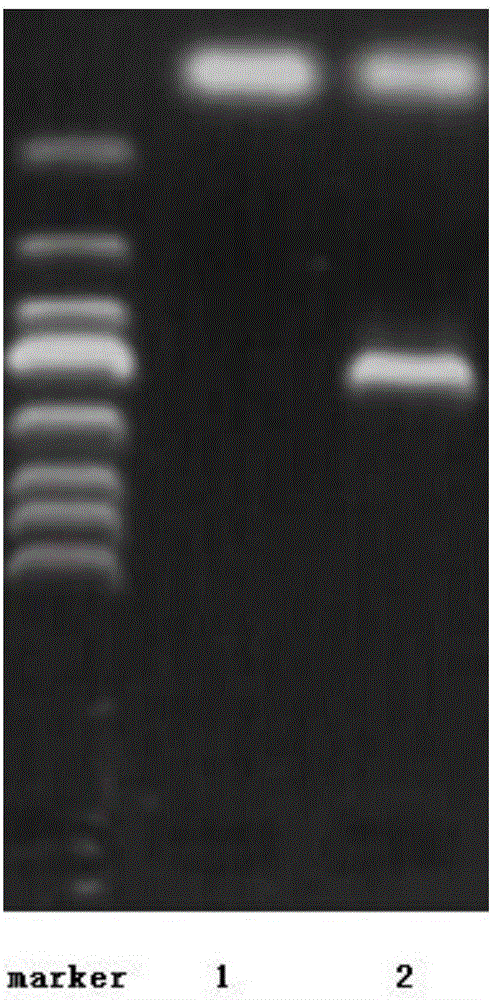Method for allowing transformed-external-source desoxyribonucleic acid to enter rhizopus stolonifer resting spores
A technology of deoxyribonucleic acid and Rhizopus staphylococcus, which is applied in the biological field and achieves the effects of simple steps and low conversion rate
- Summary
- Abstract
- Description
- Claims
- Application Information
AI Technical Summary
Problems solved by technology
Method used
Image
Examples
Embodiment 1
[0058] A method for transforming exogenous deoxyribonucleic acid into the dormant spores of Rhizopus staphylococcus, comprising the following steps:
[0059] 1) Rhizopus staphylococcus culture and spore collection
[0060] In a 15cm petri dish, prepare a solid agar medium (PDA medium), inoculate the surface of the solid agar medium with Rhizopus staphylococcus CICC 40325, the temperature is 28°C, the humidity is 50-60%, and cultured for 6 days, let the surface of the medium grow. Full of Rhizopus staphylococcus spores.
[0061] Pour sterile water on the surface of the medium, wash off (shake, or gently scrape with a smooth sterile glass coating rod) the spores of Rhizopus staphylococcus on the surface of the medium, suck out the spore suspension with a pipette, and use Filter the sterilized lens paper (or sand core funnel, filter paper, etc.) to remove the mycelium and retain the spores. The filtered liquid is placed in a centrifuge tube. After centrifugation, the precipitate...
Embodiment 2
[0085] A method for transforming exogenous deoxyribonucleic acid into the dormant spores of Rhizopus staphylococcus, comprising the following steps:
[0086] 1) Rhizopus staphylococcus culture and spore collection
[0087] In a 15cm petri dish, prepare a solid agar medium (YPD medium), inoculate the surface of the solid agar medium with Rhizopus staphylococcus CICC 40325, and cultivate for 15 days at a temperature of 16°C and a humidity of 15-50%, and let the medium Surface covered with Rhizopus staphylococcus spores.
[0088] Pour sterile water on the surface of the medium, wash off (shake, or gently scrape with a smooth sterile glass coating rod) the spores of Rhizopus staphylococcus on the surface of the medium, suck out the spore suspension with a pipette, and use Filter the sterilized lens paper (or sand core funnel, filter paper, etc.) to remove the mycelium and retain the spores. The filtered liquid is placed in a centrifuge tube. After centrifugation, the precipitated...
Embodiment 3
[0102] A method for transforming exogenous deoxyribonucleic acid into the dormant spores of Rhizopus staphylococcus, comprising the following steps:
[0103] 1) Rhizopus staphylococcus culture and spore collection
[0104] In a 15cm petri dish, prepare a solid agar medium (PDA medium), inoculate the surface of the solid agar medium with Rhizopus staphylococcus CICC 40325, and cultivate it for 3 days at a temperature of 40°C and a humidity of 60-85%, and let the medium Surface covered with Rhizopus staphylococcus spores.
[0105] Pour sterile water on the surface of the medium, wash off (shake, or gently scrape with a smooth sterile glass coating rod) the spores of Rhizopus staphylococcus on the surface of the medium, suck out the spore suspension with a pipette, and use Filter the sterilized lens paper (or sand core funnel, filter paper, etc.) to remove the mycelium and retain the spores. The filtered liquid is placed in a centrifuge tube. After centrifugation, the precipitat...
PUM
 Login to View More
Login to View More Abstract
Description
Claims
Application Information
 Login to View More
Login to View More - R&D
- Intellectual Property
- Life Sciences
- Materials
- Tech Scout
- Unparalleled Data Quality
- Higher Quality Content
- 60% Fewer Hallucinations
Browse by: Latest US Patents, China's latest patents, Technical Efficacy Thesaurus, Application Domain, Technology Topic, Popular Technical Reports.
© 2025 PatSnap. All rights reserved.Legal|Privacy policy|Modern Slavery Act Transparency Statement|Sitemap|About US| Contact US: help@patsnap.com

